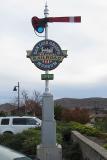
| Home | Open Account | Help | 307 users online |
|
Member Login
Discussion
Media SharingHostingLibrarySite Info |
Railroaders' Nostalgia > Signal mast finialsDate: 09/09/18 09:54 Signal mast finials Author: mile250 TO has a section for railFAN technology. I wish it had one for railROAD technology.
So, for all you signal maintainers out there: What was the purpose of finials on signal masts? I thought the answer would be straightforward until I checked some seemingly reliable sources and found these claims:
 Date: 09/09/18 10:25 Re: Signal mast finials Author: PHall I'll believe the first two, but to serve as a "lightning rod"? Believe me a lightning strike is going to fry everything electrical in that signal. Lamps, motors, relays and all.
Date: 09/10/18 08:49 Re: Signal mast finials Author: ButteStBrakeman Glen,
I would have to agree with P. The first two are plausible, but not the lightning rod. Butte St Brakeman Date: 09/10/18 10:25 Re: Signal mast finials Author: jtwlunch Keeping water, snow, ice out of the pole itself too.
Date: 09/15/18 19:21 Re: Signal mast finials Author: rrman6 jtwlunch Wrote:
------------------------------------------------------- > Keeping water, snow, ice out of the pole itself > too. And not just the pole (mast), but the flexible conduit leading the wiring to the motor housing, but most of all, keep these natures products from entering the relay cabinets below the mast as well. These finials once fitted over the mast usually had a single bolt to lock it to the mast. Most had some slack between the finial and the mast so they weren't entirely sealed as water tight. I have one AT&SF that for some reason was made water tight by an appliction of asphalt sealant to the joint that was later painted over with the aluiminum paint. Date: 09/15/18 21:35 Re: Signal mast finials Author: PHall When talking about electrical stuff, nothing is really "water proof". Water will find a way in. It always will.
Date: 09/22/18 09:23 Re: Signal mast finials Author: GBW309 The finial usually overlaps the pole by 3-4 inches. Unless you are in a hurricane, it's going to do a pretty good job of keeping water out of the pole.
Dave Date: 09/22/18 11:43 Re: Signal mast finials Author: LarryDoyle GBW309 Wrote:
------------------------------------------------------- > The finial usually overlaps the pole by 3-4 > inches. Unless you are in a hurricane, it's > going to do a pretty good job of keeping water out > of the pole. Wooden poles had their tops sawn or adzed at an angle, or peaked, or pointed so that rainwater would run off. Very important to prevent water from standing on top of the pole causing rot. This was especially true for utility lines, communications lines and streecar/interurban overhead. The Milwaukees electrification used wooden poles right up to the end Early railroad signals also used wooden poles, but metal quickly became standard construction. The finial placed on top to kieep water out imitated the top of wooden poles. The finial sat atop the pole, slipping over the outside of the pole, as illustrated below. I've also included a drawing of a streetcar pole showing a cap (finial) that is insulated and has a screw-eye to support the trolley span wire. -Larry Doyle   Date: 09/23/18 14:02 Re: Signal mast finials Author: PHall GBW309 Wrote:
------------------------------------------------------- > The finial usually overlaps the pole by 3-4 > inches. Unless you are in a hurricane, it's > going to do a pretty good job of keeping water out > of the pole. > > Dave You would be amazed how easily water can get in. Fog or even condensation will get water inside. Maybe not fast or in large quantities, but it only takes a little moisture to do it's thing. Moisture + copper + electricity = corrosion (aka wire cancer) Date: 09/25/18 12:35 Re: Signal mast finials Author: spnudge Try birds, etc.
The finial would not let birds sit and crap all over or set up house keeping. There was just one or two set screws holding the tops on. Also, didn't want other critters making a home inside where it could jam the gears or block the rods from moving. Lightning would just melt and blow everything. There were "protectors" that kept high voltage from traveling down to the next signal but have no idea what their success was. I know if AC or high voltage was introduced on low voltage wires, it could weld the relay contacts together, making a signal stick in a green or yellow indication, even with an H-Head. Nudge Date: 09/25/18 19:51 Re: Signal mast finials Author: PHall spnudge Wrote:
------------------------------------------------------- > Try birds, etc. > > The finial would not let birds sit and crap all > over or set up house keeping. There was just one > or two set screws holding the tops on. Also, > didn't want other critters making a home inside > where it could jam the gears or block the rods > from moving. > > Lightning would just melt and blow everything. > There were "protectors" that kept high voltage > from traveling down to the next signal but have no > idea what their success was. I know if AC or high > voltage was introduced on low voltage wires, it > could weld the relay contacts together, making a > signal stick in a green or yellow indication, even > with an H-Head. > > > > Nudge The protectors did their job by vaporizing and opening the circuit during a lightning strike. Have replaced more then a few on telephone lines. |